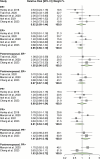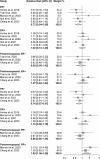Exposure to per- and polyfluoroalkyl substances and breast cancer risk: a systematic review and meta-analysis of epidemiologic studies
- PMID: 38400646
- PMCID: PMC11299034
- DOI: 10.1093/aje/kwae010
Exposure to per- and polyfluoroalkyl substances and breast cancer risk: a systematic review and meta-analysis of epidemiologic studies
Abstract
We synthesized the epidemiologic evidence on the associations between per- and polyfluoroalkyl substances (PFAS) exposure and breast cancer risk. Our systematic review and meta-analysis included 18 and 11 articles, respectively, covering studies up to February 2023. The summary relative risks (RRs) estimated by random-effects meta-analyses did not support an association between PFAS and overall breast cancer risk (eg, a natural log (ln)-unit increase in serum/plasma concentrations [ng/mL] for perfluorooctanoate [PFOA] RR = 0.95; 95% CI, 0.77-1.18; perfluorooctane sulfonate [PFOS] RR = 0.98; 95% CI, 0.87-1.11). However, when limiting to studies that assessed exposures prior to a breast cancer diagnosis, we observed a positive association with PFOA (a ln-unit increase, RR = 1.16; 95% CI, 0.96-1.40). We also observed some possible heterogeneous associations by tumor estrogen and progesterone receptor status among postmenopausal breast cancer cases. No meaningful changes were observed after excluding the studies with high risk of bias (Tier 3). Based on the evaluation tool developed by the National Toxicology Program, given the heterogeneity across studies and the variability in timing of exposure measurements, the epidemiologic evidence needed to determine the association between PFAS exposure and breast cancer remains inadequate. Our findings support the need for future studies with improved study designs to determine this association.
Keywords: PFAS; breast cancer; epidemiologic study; meta-analysis; per- and polyfluoroalkyl substances; systematic review.
Published by Oxford University Press on behalf of the Johns Hopkins Bloomberg School of Public Health 2024.
Conflict of interest statement
The authors declare that they have no known competing financial interests or personal relationships that could have appeared to influence the work reported in this paper.
Figures





Similar articles
-
Examining the relationship between per-and polyfluoroalkyl substances and breast, colorectal, prostate, and ovarian cancers: a meta-analysis.Crit Rev Toxicol. 2024 Nov;54(10):981-995. doi: 10.1080/10408444.2024.2425669. Epub 2024 Dec 5. Crit Rev Toxicol. 2024. PMID: 39636584
-
Exposure to perfluoroalkyl and polyfluoroalkyl substances and risk of stroke in adults: a meta-analysis.Rev Environ Health. 2023 Sep 4;39(4):791-800. doi: 10.1515/reveh-2023-0021. Print 2024 Dec 17. Rev Environ Health. 2023. PMID: 37656598 Review.
-
Prenatal exposure to PFAS and the association with neurobehavioral and social development during childhood.Int J Hyg Environ Health. 2025 Jan;263:114469. doi: 10.1016/j.ijheh.2024.114469. Epub 2024 Sep 25. Int J Hyg Environ Health. 2025. PMID: 39326240
-
Mobile apps to reduce depressive symptoms and alcohol use in youth: A systematic review and meta-analysis: A systematic review.Campbell Syst Rev. 2024 Apr 26;20(2):e1398. doi: 10.1002/cl2.1398. eCollection 2024 Jun. Campbell Syst Rev. 2024. PMID: 38680950 Free PMC article. Review.
-
Prenatal exposure to per- and polyfluoroalkyl substances (PFAS) and associations with hypertensive disorders of pregnancy in the Atlanta African American Maternal-Child cohort.Chemosphere. 2024 Jun;357:142052. doi: 10.1016/j.chemosphere.2024.142052. Epub 2024 Apr 16. Chemosphere. 2024. PMID: 38631500
Cited by
-
PFAS Levels, Early Life Factors, and Mammographic Breast Density in Premenopausal Women.Environ Health Perspect. 2024 Sep;132(9):97008. doi: 10.1289/EHP14065. Epub 2024 Sep 18. Environ Health Perspect. 2024. PMID: 39292675 Free PMC article.
References
-
- World Cancer Research . Worldwide cancer data. 2023. Accessed June 28, 2023. https://www.wcrf.org/cancer-trends/worldwide-cancer-data/
-
- Collaborative Group on Hormonal Factors in Breast Cancer . Menarche, menopause, and breast cancer risk: individual participant meta-analysis, including 118 964 women with breast cancer from 117 epidemiological studies. Lancet Oncol. 2012;13(11):1141–1151. 10.1016/S1470-2045(12)70425-4 - DOI - PMC - PubMed
Publication types
MeSH terms
Substances
Grants and funding
LinkOut - more resources
Full Text Sources
Medical
Research Materials

